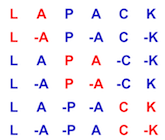 |
LAPACK
3.9.0
LAPACK: Linear Algebra PACKage
|
 |
LAPACK
3.9.0
LAPACK: Linear Algebra PACKage
|
| subroutine ctplqt2 | ( | integer | M, |
| integer | N, | ||
| integer | L, | ||
| complex, dimension( lda, * ) | A, | ||
| integer | LDA, | ||
| complex, dimension( ldb, * ) | B, | ||
| integer | LDB, | ||
| complex, dimension( ldt, * ) | T, | ||
| integer | LDT, | ||
| integer | INFO | ||
| ) |
CTPLQT2
CTPLQT2 computes a LQ a factorization of a complex "triangular-pentagonal" matrix C, which is composed of a triangular block A and pentagonal block B, using the compact WY representation for Q.
| [in] | M | M is INTEGER
The total number of rows of the matrix B.
M >= 0. |
| [in] | N | N is INTEGER
The number of columns of the matrix B, and the order of
the triangular matrix A.
N >= 0. |
| [in] | L | L is INTEGER
The number of rows of the lower trapezoidal part of B.
MIN(M,N) >= L >= 0. See Further Details. |
| [in,out] | A | A is COMPLEX array, dimension (LDA,M)
On entry, the lower triangular M-by-M matrix A.
On exit, the elements on and below the diagonal of the array
contain the lower triangular matrix L. |
| [in] | LDA | LDA is INTEGER
The leading dimension of the array A. LDA >= max(1,M). |
| [in,out] | B | B is COMPLEX array, dimension (LDB,N)
On entry, the pentagonal M-by-N matrix B. The first N-L columns
are rectangular, and the last L columns are lower trapezoidal.
On exit, B contains the pentagonal matrix V. See Further Details. |
| [in] | LDB | LDB is INTEGER
The leading dimension of the array B. LDB >= max(1,M). |
| [out] | T | T is COMPLEX array, dimension (LDT,M)
The N-by-N upper triangular factor T of the block reflector.
See Further Details. |
| [in] | LDT | LDT is INTEGER
The leading dimension of the array T. LDT >= max(1,M) |
| [out] | INFO | INFO is INTEGER
= 0: successful exit
< 0: if INFO = -i, the i-th argument had an illegal value |
The input matrix C is a M-by-(M+N) matrix
C = [ A ][ B ]
where A is an lower triangular M-by-M matrix, and B is M-by-N pentagonal
matrix consisting of a M-by-(N-L) rectangular matrix B1 left of a M-by-L
upper trapezoidal matrix B2:
B = [ B1 ][ B2 ]
[ B1 ] <- M-by-(N-L) rectangular
[ B2 ] <- M-by-L lower trapezoidal.
The lower trapezoidal matrix B2 consists of the first L columns of a
N-by-N lower triangular matrix, where 0 <= L <= MIN(M,N). If L=0,
B is rectangular M-by-N; if M=L=N, B is lower triangular.
The matrix W stores the elementary reflectors H(i) in the i-th row
above the diagonal (of A) in the M-by-(M+N) input matrix C
C = [ A ][ B ]
[ A ] <- lower triangular M-by-M
[ B ] <- M-by-N pentagonal
so that W can be represented as
W = [ I ][ V ]
[ I ] <- identity, M-by-M
[ V ] <- M-by-N, same form as B.
Thus, all of information needed for W is contained on exit in B, which
we call V above. Note that V has the same form as B; that is,
W = [ V1 ][ V2 ]
[ V1 ] <- M-by-(N-L) rectangular
[ V2 ] <- M-by-L lower trapezoidal.
The rows of V represent the vectors which define the H(i)'s.
The (M+N)-by-(M+N) block reflector H is then given by
H = I - W**T * T * W
where W^H is the conjugate transpose of W and T is the upper triangular
factor of the block reflector. Definition at line 164 of file ctplqt2.f.